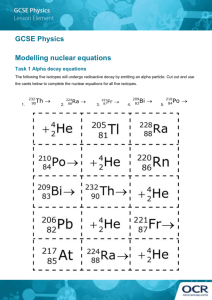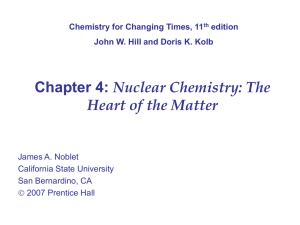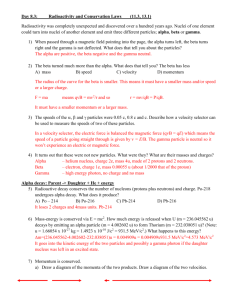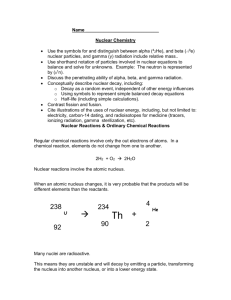Name: 1. Which type of radiation has neither mass nor charge? 1
advertisement
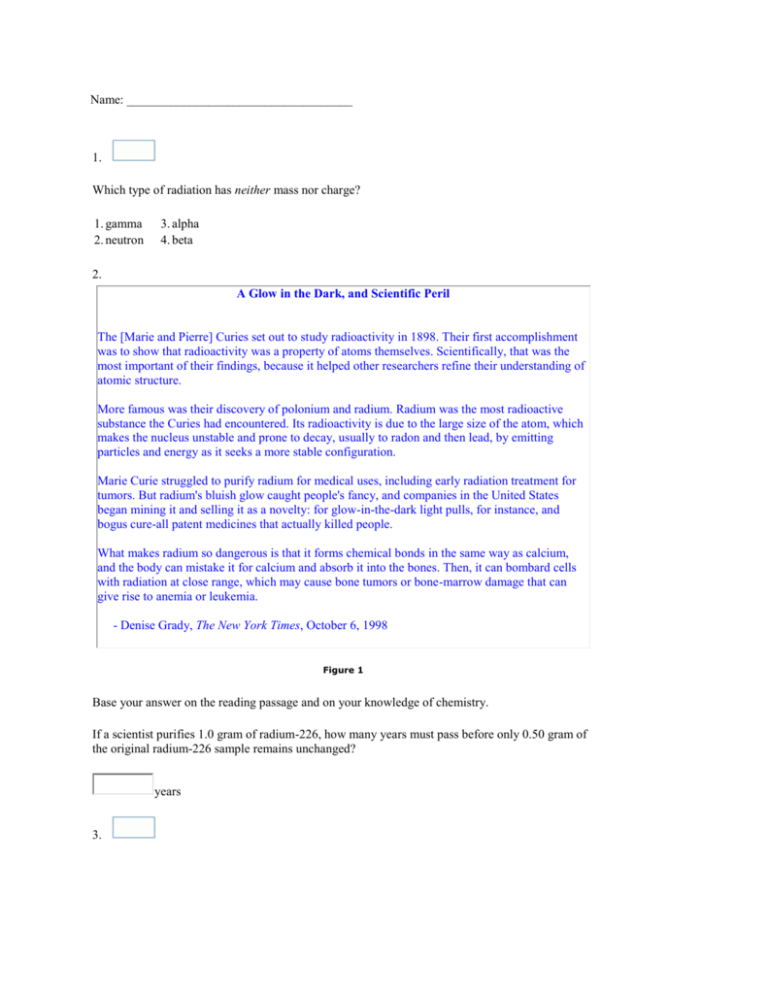
Name: ____________________________________ 1. Which type of radiation has neither mass nor charge? 1. gamma 2. neutron 3. alpha 4. beta 2. A Glow in the Dark, and Scientific Peril The [Marie and Pierre] Curies set out to study radioactivity in 1898. Their first accomplishment was to show that radioactivity was a property of atoms themselves. Scientifically, that was the most important of their findings, because it helped other researchers refine their understanding of atomic structure. More famous was their discovery of polonium and radium. Radium was the most radioactive substance the Curies had encountered. Its radioactivity is due to the large size of the atom, which makes the nucleus unstable and prone to decay, usually to radon and then lead, by emitting particles and energy as it seeks a more stable configuration. Marie Curie struggled to purify radium for medical uses, including early radiation treatment for tumors. But radium's bluish glow caught people's fancy, and companies in the United States began mining it and selling it as a novelty: for glow-in-the-dark light pulls, for instance, and bogus cure-all patent medicines that actually killed people. What makes radium so dangerous is that it forms chemical bonds in the same way as calcium, and the body can mistake it for calcium and absorb it into the bones. Then, it can bombard cells with radiation at close range, which may cause bone tumors or bone-marrow damage that can give rise to anemia or leukemia. - Denise Grady, The New York Times, October 6, 1998 Figure 1 Base your answer on the reading passage and on your knowledge of chemistry. If a scientist purifies 1.0 gram of radium-226, how many years must pass before only 0.50 gram of the original radium-226 sample remains unchanged? years 3. According to Reference Table N, which radioactive isotope will retain only one-eighth original radioactive atoms after approximately 43 days? 1. gold-198 2. iodine-131 3. phosphorus-32 4. radon-222 4. Which sample will decay least over a period of 30 days? (Refer to Reference Table N.) 1. 10 g of Au-198 2. 10 g of I-131 3. 10 g of P-32 4. 10 g of Rn-222 5. Given the reaction: Which particle is represented by X? 1. alpha 2. beta 3. neutron 4. proton 6. Which particle is represented by the letter X ? 1. an alpha particle 2. a beta particle 3. a neutron 4. a proton 7. Which radioactive emanations have a charge of 2+? 1. alpha particles 2. beta particles 3. gamma rays 4. neutrons 8. Which reaction illustrates fusion? 1. 2. 3. its 4. 9. 2 Figure The diagram represents radioactive emanations passing through an electric field. Which type of emanation is represented by the arrow labeled 1? 1. alpha particle 2. beta particle 3. positron 4. gamma ray 10. The stability of an isotope is based on its 1. 2. 3. 4. number of neutrons, only number of protons, only ratio of neutrons to protons ratio of electrons to protons 11. The half-life of 131I is 8.07 days. What fraction of a sample of 131I remains after 24.21 days? 1. 2. 3. 4. 12. How many days are required for 200. grams of radon-222 to decay to 50.0 grams? 1. 1.91 days 2. 3.82 days 3. 7.64 days 4. 11.5 days 13. When undergoes a natural transmutation reaction, it emits 1. an alpha particle 2. a beta particle 3. a proton 4. a neutron 14. Which process converts an atom from one element to another, when the nucleus of an atom is bombarded with high-energy particles? 1. 2. 3. 4. artificial transmutation natural transmutation addition polymerization condensation polymerization 15. Which radioisotope is used to diagnose thyroid disorders? 1. cobalt-60 2. iodine-131 3. technetium-99 4. uranium-238 16. A particle accelerator can increase the kinetic energy of 1. 2. 3. 4. an alpha particle and a beta particle an alpha particle and a neutron a gamma ray and a beta particle a neutron and a gamma ray 17. Which equation is an example of artificial transmutation? 1. 2. 3. 4. 18. + + U + 3F2 UF6 Mg(OH)2 + 2HCl 2H2O + MgCl2 Ca + 2H2O Ca(OH)2 + H2 Given the fusion reaction: + X + energy Which particle is represented by X? 1. 2. 3. 4. 19. As a sample of the radioactive isotope 131I decays, its half-life 1. 2. 3. decreases increases remains the same 20. In a nuclear fusion reaction, the mass of the products is 1. 2. 3. 4. less than the mass of the reactants because some of the mass has been converted to energy less than the mass of the reactants because some of the energy has been converted to mass more than the mass of the reactants because some of the mass has been converted to energy more than the mass of the reactants because some of the energy has been converted to mass 21. Which equation is an example of artificial transmutation? 1. 2. 3. 4. 22. Which of these types of nuclear radiation has the greatest penetrating power? 1. alpha 2. beta 3. neutron 4. gamma 23. What is the name of the process in which the nucleus of an atom of one element is changed into the nucleus of an atom of a different element? 1. decomposition 2. transmutation 3. substitution 4. reduction 24. Which fields are used in accelerators to speed up charged particles? 1. 2. 3. 4. magnetic fields, only electric fields, only magnetic and electric fields magnetic and gravitational fields 25. After 30 days, 5.0 grams of a radioactive isotope remains from an original 40.-gram sample. What is the half-life of this element? 1. 5 days 2. 10 days 3. 15 days 4. 20 days 26. Given the nuclear equation: equation? 1. 2. 3. 4. 27. When cobalt-60 undergoes nuclear decay, it emits 1. a positron 2. a neutron 28. 3. a beta particle 4. an alpha particle What is the identity of particle X in this Which equation represents a fusion reaction? 1. 2. 3. 4. 29. Compared to 37K, the isotope 42K has a 1. 2. 3. 4. shorter half-life and the same decay mode shorter half-life and a different decay mode longer half-life and the same decay mode longer half-life and a different decay mode 30. A positively charged particle has great difficulty penetrating a target nucleus because the target nucleus has 1. 2. 3. 4. a positive charge, which repels the particle a negative charge, which attracts the particle the protection of surrounding electrons a very high binding energy 31. Which particle cannot be accelerated in a magnetic field? 1. alpha particle 2. beta particle 3. neutron 4. proton 32. According to Table N, which radioactive isotope is best for determining the actual age of Earth? 1. 238U 2. 90Sr 3. 60Co 4. 14C 33. The half-life of a radioactive substance is 2.5 minutes. What fraction of the original radioactive substance remains after 10 minutes? 1. 2. 3. 4. 34. Which kind of particle, when passed through an electric field, would be attracted to the negative electrode? 1. an alpha particle 2. a beta particle 3. a neutron 4. an electron 35. Which radioisotope undergoes beta decay and has a half-life of less than 1 minute? 1. Fr-220 2. K-42 3. N-16 4. P-32 36. Which radioactive sample would contain the greatest remaining mass of the radioactive isotope after 10 years? 1. 2. 3. 4. 2.0 grams of 198Au 2.0 grams of 42K 4.0 grams of 32P 4.0 grams of 60Co 37. Alpha particles are emitted during the radioactive decay of 1. carbon-14 2. neon-19 3. calcium-37 4. radon-222 38. Which of the following particles has the greatest mass? 1. an alpha particle 2. a beta particle 3. a proton 4. an electron 39. Which statement explains why nuclear waste materials may pose a problem? 1. 2. 3. 4. They frequently have short half-lives and remain radioactive for brief periods of time. They frequently have short half-lives and remain radioactive for extended periods of time. They frequently have long half-lives and remain radioactive for brief periods of time. They frequently have long half-lives and remain radioactive for extended periods of time. 40. Which type of radioactive emission has a positive charge and weak penetrating power? 1. alpha particle 2. beta particle 3. gamma ray 4. neutron 41. Alpha particles and beta particles differ in 1. mass, only 2. charge, only 3. both mass and charge 4. neither mass nor charge 42. Which of these particles has the greatest mass? 1. alpha 2. beta 3. neutron 4. positron 43. After 32 days, 5 milligrams of an 80-milligram sample of a radioactive isotope remains unchanged. What is the half-life of this element? 1. 8 days 2. 2 days 3. 16 days 4. 4 days 44. Which reaction represents natural nuclear decay? 1. 2. 3. 4. 45. Exactly how much time must elapse before 16 grams of potassium-42 decays, leaving 2 grams of the original isotope? 1. 2. 3. 4. 8 ×12.4 hours 2 ×12.4 hours 3 ×12.4 hours 4 ×12.4 hours 46. Which equation represents a spontaneous nuclear decay? 1. 2. C + O2 H2CO3 CO2 CO2 + H2O 3. 4. 47. Figure 3 A mixture of emanations from radioactive atoms is passed through electrically charged plates, as shown in the diagram. The nuclear emanations labeled 1, 2, and 3 are called, respectively 1. alpha, beta, and gamma 2. beta, gamma, and alpha 3. gamma, alpha, and beta 4. gamma, beta, and alpha 48. A sample of 131I decays to 1.0 gram in 40 days. What was the mass of the original sample? 1. 8.0 g 3. 32 g 2. 16 g 4. 4.0 g 49. The change that is undergone by an atom of an element made radioactive by bombardment with high-energy protons is called 1. 2. 3. 4. natural transmutation artificial transmutation natural decay radioactive decay 50. If 3.0 grams of strontium-90 in a rock sample remained in 1989, approximately how many grams of strontium-90 were present in the original rock sample in 1933? 1. 9.0 g 2. 6.0 g 3. 3.0 g 4. 12. g Answer Key for Nuclear chemistry 1. 1 2. 1600 3. 3 4. 3 5. 2 6. 2 7. 1 8. 1 9. 2 10. 3 11. 3 12. 3 13. 1 14. 1 15. 2 16. 1 17. 1 18. 4 19. 3 20. 1 21. 2 22. 4 23. 2 24. 3 25. 2 26. 1 27. 3 28. 1 29. 4 30. 1 31. 3 32. 1 33. 4 34. 1 35. 3 36. 4 37. 4 38. 1 39. 4 40. 1 41. 3 42. 1 43. 1 44. 3 45. 3 46. 4 47. 2 48. 3 49. 2 50. 4
